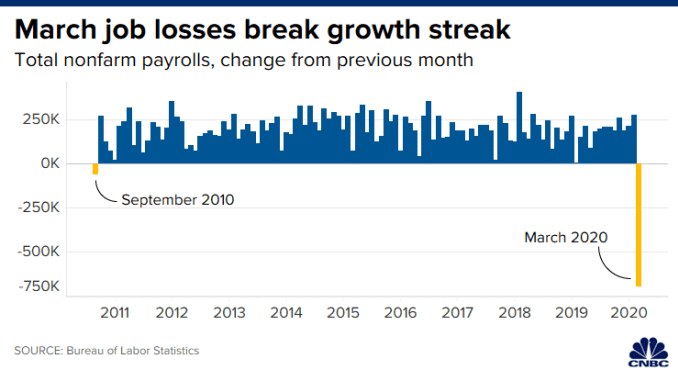- Nonfarm payrolls in March fell by 701,000 and the unemployment rate rose to 4.4%.
- The numbers just begin to capture the beginning of the job market collapse brought up by efforts to contain the coronavirus.
- This was the first decline in payroll growth since September 2010.

Nonfarm payrolls dropped by 701,000 in March, according to Labor Department numbers released Friday that only begin to show the economic damage wrought by the coronavirus crisis.
It was the first decline in payrolls since September 2010 and came close to the May 2009 financial crisis peak of 800,000. Some two-thirds of the drop came in the hospitality industry, particularly bars and restaurants forced to close during the economic shutdown.
That headline number reflects the count from establishments the government surveyed for its report. The household survey, which asks individual residences about their employment situation, showed a plunge of nearly 3 million.

The unemployment rate rose to 4.4% — from 3.5% — its highest level since August 2017 as employers just began to cut payrolls ahead of social distancing practices that shut down large swaths of the U.S. economy in order to stop the virus’s spread. An alternative measure that captures discouraged workers and those holding jobs part time for economic reasons jumped from 7% to 8.7%, its highest since March 2017.
Those higher unemployment rates come amid a tumble in the labor force participation rate to 62.7%, a 0.7 percentage point fall and the lowest since August 2018 for a number that had been gradually rising.

Despite the other bad numbers, wages continued to rise, increasing 3.1% year over year, slightly better than expected.
Economists surveyed by Dow Jones had been looking for a payroll decline of 10,000 and for the unemployment rate to rise to 3.7%.
“Today’s numbers are shockingly bad and an understatement of the damage already done to the U.S. economy,” said Nick Bunker, economic research director at job search site Indeed. “If this is an indication of what was happening before the full force of the crisis hit, then it will be hard to come up with the words to describe the numbers in future months.”

The report fails to capture the full damage from the virus because of government methodology. The Bureau of Labor Statistics used as its reference period the week ending March 12, which came just as the nation began its near shutdown.
A better picture of how profound the damage has been comes from the weekly initial jobless claims reports, which have shown 10 million new filings for unemployment insurance over the past two weeks. Both weeks have far and away eclipsed anything the U.S. has ever seen in terms of job losses.
“My sense is that when we get April data a month from now, we’ll see that the economy lost somewhere between 10 and 15 million jobs,” Mark Zandi, chief economist at Moody’s Analytics, said earlier this week. “That would be consistent with the initial claims for unemployment insurance data that we’re getting.”
Prior to the coronavirus hit, the economy had been humming along with an unemployment rate of 3.5%, the lowest in more than 50 years.
Though the March report does not capture the full extent of the employment collapse, it does hint at what’s to come. Citigroup estimated that the April count will show job losses “closer to 10 million.”
Workers who reported being on temporary layoff more than doubled to 1.8 million, while those who said they were jobless for less than five weeks surged 75% to 1.5 million. The ranks of permanent job losers grew by 177,000 to 1.5 million.
Leisure and hospitality led the decline with 459,000 job losses, with 417,000 coming from food and drinking establishments. The Bureau of Labor Statistics noted that the drop nearly wiped out all of the gains from the past two years.
Health care and social assistance lost 61,000, professional and business services declined by 52,000 and retail fell 46,000. Construction dropped 29,000 while other services industries combined to lose 24,000, led by a 13,000 contraction in personal and laundry services.
One of the few areas to gain was government, which added 18,000, due mostly to the hiring of 17,000 Census workers.
Revisions took down numbers from the previous two readings. January moved down 59,000 to 214,000 while February’s much stronger than expected number was revised up by 2,000 to 275,000, resulting in a net 57,000 loss for the two months.